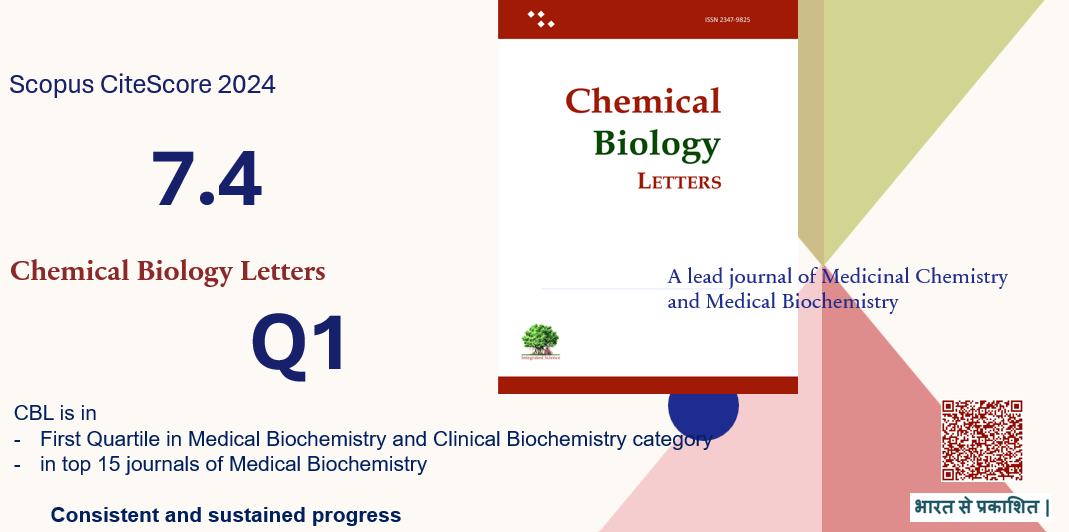Category: Medicinal Chemistry
-

CBL2025 Scopus citescore matrices
The Scopus Journal Metrics for 2024 were released on June 2nd, 2025, and Chemical Biology Letters (CBL) has maintained its sustained performance. Good to share that CBL holds the same rank with a CiteScore of 7.4 and sustains the first quartile within the Medical Biochemistry category. This places CBL among the top 15 journals in…
-
Antimicrobial Peptides in Tuberculosis: Insights into the Immunomodulatory Mechanisms
Antimicrobial Peptides in Tuberculosis: Insights into the Immunomodulatory Mechanisms Tuberculosis is a highly contagious airborne disease that remains one of the leading causes of mortality worldwide. In the era of an increasing rate of drug-resistant strains and other shortcomings of current anti-TB therapies, we promptly need new, effective treatments to combat tuberculosis. Antimicrobial peptides have…
-
Investigating the effect of calcitonin gene-related peptide antagonist and exercise trainings in rat aorta: Mitophagy, mitochondrial biogenesis, and apoptosis
Investigating the effect of calcitonin gene-related peptide antagonist and exercise trainings in rat aorta: Mitophagy, mitochondrial biogenesis, and apoptosis Calcitonin Gene Related Peptide (CGRP) is expressed in the cardiovascular system and showed vasodilatory effects. This study aimed to investigate the effects of exercise training and a CGRP antagonist (CGRPi) on the expression of genes involved…
-
Uncovering the potential of Fatty Acid Binding Proteins for predicting radiation-induced gastrointestinal injury
Uncovering the potential of Fatty Acid Binding Proteins for predicting radiation-induced gastrointestinal injury Gastrointestine (GI) depression is a severe complication identified in individuals after intentional or unintentional radiation exposure. Early detection of radiation-induced GI injury (RIGI) is important for medical management with supportive care, which can largely be achieved using organ specific biomarkers. Fatty Acid…
-
Unveiling the effect of Inflammatory Cytokines TNF-α, IL-6, and IL-1β in Breast Cancer prevalence and progression
Unveiling the effect of Inflammatory Cytokines TNF-α, IL-6, and IL-1β in Breast Cancer prevalence and progression Breast cancer remains a leading cause of cancer-related morbidity and mortality among women globally. Breast cancer is the most diagnosed cancer in women. Metastasis is the primary cause of mortality for breast cancer patients. In Bihar, there are so…
-
Pioglitazone and Ezetimibe combination improves Liver histopathology and biochemistry in experimental MASH models
Pioglitazone and Ezetimibe combination improves Liver histopathology and biochemistry in experimental MASH models Metabolic dysfunction-associated steatotic liver disease (MASLD) and metabolic dysfunction-associated steatohepatitis (MASH) are common clinico-pathological conditions that affecting over 30% of adults worldwide. Insulin resistance and hepatic lipid accumulation constitute the metabolic foundation of MASLD/MASH. Although previous studies have shown limited efficacy of…
-
Epitope-based Vaccine development: A detailed overview from in-silico vaccine design to wet lab validation
Epitope-based Vaccine development: A detailed overview from in-silico vaccine design to wet lab validation In-silico epitope-based vaccine is the cornerstone of modern vaccine development and is illuminating by a growing number of experimental and computational methods. The reverse vaccinology approach uses computational screening of the whole proteome of a pathogen to identify the proteins with…
-
Progress of Chemical Sciences in Russia
Special Collection for recent progress in Chemical Sciences research in Russia
-
Acetamiprid exposure causes molecular and structural changes in the liver and kidney tissues of rats
Acetamiprid exposure causes molecular and structural changes in the liver and kidney tissues of rats Pesticides are among the most widely used synthetic chemicals worldwide to protect crops, but they pose several environmental and health issues. The present study evaluates toxic effects of acetamiprid (ACMP) in rat liver and kidney tissues. Rats were exposed to…
-
A novel Fusion-5 Filter based Micro-chip: A highly efficient, On-chip DNA extraction and On-chip PCR amplification for rapid detection
A novel Fusion-5 Filter based Micro-chip: A highly efficient, On-chip DNA extraction and On-chip PCR amplification for rapid detection A novel, sensitive, portable method for detecting DNA from various human samples is most desirable. This study aims to develop a microdevice for on-chip DNA extraction and detection by PCR from various forensic samples. A microchip…
